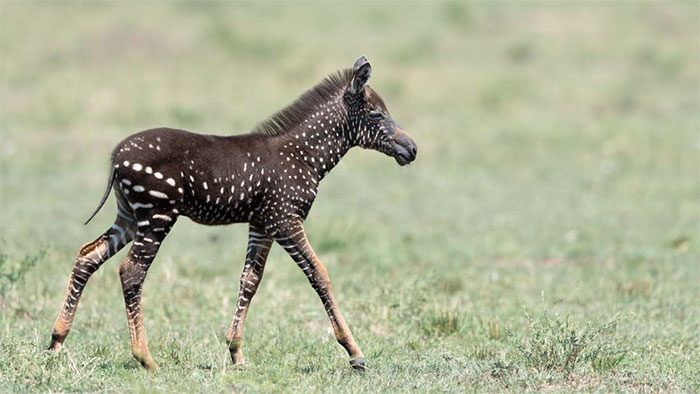Spotted zebras appear on African pastures
With a brown spotted white coat due to a genetic mutation, young zebras can be at risk in the wild.

Tira's zebra strikingly with white spotted brown fur.(Photo: IFL Science).
Tour guide in Maasai Mara Reserve, Kenya, discovered a young zebra with unusual fur color and named it Tira, IFL Science on September 17 reported. "We knew about the same situation a few years ago, but that zebra retained its stripes and a ruffled tail. Meanwhile, Tira's motifs turned into polka dots , " the program representative said. Wildest Africa share on social networks.
Tira may have a genetic mutation and melanism will cause melanoma to become abundant. Its coat color varies abnormally. Zebras often have stripes around their backs and legs, and completely white bellies. However, Tira has a brownish-white belly with a brown back. This is not the first time people have discovered melanism infected with melanism. Professor Jonathan Bard once described a similar speckled fur case in 1977.
Zebras recognize each other with body textures. The pattern of each animal is not the same, similar to a person's fingerprint. In fact, there are three species of zebra, each with its own pattern, from the style to the position of the stripes. Scientists believe that the zebra's fur is not for camouflage but for keeping flies and flies away.
Tira may be in great danger with strange feathers. Melanism infected zebras will become prominent in the herd, especially when young. At that time, they are more likely to become targets for lions and hyenas.
Melanism occurs in many animals, of which the most common is the leopard. The opposite of melanism is albinism, when the amount of melanin is missing or completely gone. Albino is more common than melanism.
- Video: the zebra strikes a unique way to drown the lion into the mud
- Video: The zebra kicks off the stone to flip the lion's jaw
- African lions get used to cold snow in Canada
- Why are yellow-spotted fish sold at high prices?
- Zebras hit the hungry lion's face
- Hybrid between male zebras and rare female donkeys
- Death gate on the river
- Death god stalks African elephants
- Octopus is more poisonous than cobras that wash up on the coast
- Production of fish spotted by artificial method
- Close-up of blue-spotted octopus has 50 times more venom than cobra
- Mysterious beasts let out a savage laughter
 Animal 'suffering' after hibernation
Animal 'suffering' after hibernation Why do goats climb well?
Why do goats climb well? Scientists were surprised to see chimpanzees eating turtles
Scientists were surprised to see chimpanzees eating turtles Giant catfish died deadly due to drought in Thailand
Giant catfish died deadly due to drought in Thailand